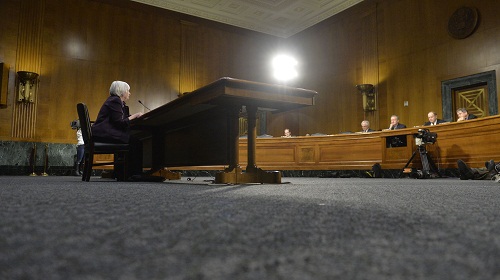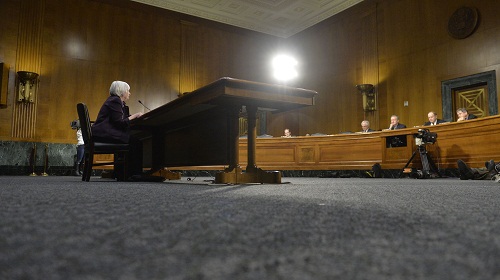 이미지 확대보기
이미지 확대보기20일 새벽에 공개된 FOMC 의사록에 따르면 중국 경제하락이 향후 미국경제에도 위기를 초래할 수 있는 의견이 개진됐다.
금리정책을 논의하면서 중국을 구체적으로 언급한 것은 이례적이다.
이는 미국 FOMC가 중국발 경제위기를 우려하여 미국이 금리인상을 더 늦출 수도 있음을 의미하는 신호로 받아들여지고 있다.
While the recent Chinese stock market decline seemed to have had limited implications to date for the growth outlook in China, several participants noted that a material slowdown in Chinese economic activity could pose risks to the U.S. economic outlook.
의사록이 작성된 것은 7월29일이다.
이후 중국의 주가는 또 떨어졌다.
평가절하 파동도 있었다.
이러한 변수를 감안하면 중국 때문에 미국이 금리인상사을 늦출 것이라는 세간의 지적이 그대로 들어맞는 셈이다.
의사록에서는 또 미국이 금리를 인상하면 다른 나라와의 금리차가 더 커져 달러 강세를 부추길 것이며 그 결과 미국의 수출이 위기에 처할 수있다는 주장도 제기됐다.
Some participants also discussed the risk that a possible divergence in interest rates in the United States and abroad might lead to further appreciation of the dollar, extending the downward pressure on commodity prices and the weakness in net exports.
다음은 의사록 중 세계경제 대목 전문.
Participants' Views on Current Conditions and the Economic Outlook
In their discussion of the economic situation and the outlook, meeting participants viewed the information received over the intermeeting period as suggesting that economic activity had been expanding moderately in recent months. The pace of job gains had been solid and the unemployment rate had declined, with a range of labor market indicators suggesting that underutilization of labor resources had continued to diminish. Participants generally viewed the incoming data as confirming their earlier assessment that the weak report on real GDP in the first quarter reflected transitory factors and expected that real economic activity would continue to expand at a moderate pace over the balance of the year, leading to further improvement in labor market conditions. However, a few participants observed that although GDP growth appeared to have picked up in recent months relative to the first-quarter pace, the level of GDP remained lower than had been projected earlier in the year. Inflation continued to run below the Committee's 2 percent longer-run objective, partly reflecting earlier declines in energy prices and further decreases in prices of non-energy imports. Market-based measures of inflation compensation remained low, while survey-based measures of longer-term inflation expectations remained stable. Participants generally anticipated that inflation would rise gradually toward 2 percent as the labor market improved further and the transitory effects of earlier declines in energy and import prices dissipated. Although many continued to see some downside risks arising from economic and financial developments abroad, participants generally viewed the risks to the outlook for domestic economic activity and the labor market as nearly balanced.
With respect to consumer spending, the incoming data had been uneven but participants cited reports from contacts suggesting a pickup since the first quarter. Participants generally expected consumer spending to rise moderately over the near term. Continued gains in employment and income, high household net worth, and low gasoline prices were viewed as factors that should support consumer spending in coming months. Consumer credit conditions were also seen as favorable, with business contacts pointing to steady loan growth, especially for auto loans and credit cards. However, a couple of participants were concerned about the outlook for consumer spending, noting that spending had been disappointing in recent months even though real income had already been boosted by the lower gasoline prices and the improved labor market.
Participants viewed the recent data on housing starts and permits as well as the higher levels of sales and prices as indicative of continued recovery in the housing sector. The easing of lending standards for residential mortgages evidenced in the most recent SLOOS was cited as a factor likely to support further progress. However, a couple of participants noted that they did not expect this sector to be a major contributor to economic growth over the remainder of the year.
Participants also observed that activity in other sectors of the economy continued to be subdued. Business fixed investment remained soft even as the drag from the sharp contraction in drilling rigs over the first half of this year appeared to be fading. Although investment spending was expected to pick up over the second half of this year, a few participants were concerned that the further decline in oil prices that had occurred in recent weeks might continue to hold down energy-related investment. In addition, government spending was expected to add very little to growth in aggregate spending this year. Participants also expected net exports to continue to subtract from GDP growth over the second half of the year, reflecting in part the damping influence of the dollar's earlier appreciation.
Industry contacts pointed to generally solid business conditions, with firms in many parts of the country continuing to report positive assessments of current activity and optimism about future sales. Manufacturing activity had slowed somewhat over the intermeeting period, but conditions were mixed across different industries. Those firms connected to the auto, aerospace, and construction industries, for example, reported strong demand. However, businesses particularly exposed to the appreciation of the dollar or falling commodity prices--including those in the heavy equipment and steel, oil and gas extraction, and petrochemical industries--reported slower activity. The service sector reports were mostly positive. Overall, most contacts viewed the recent slowdown in manufacturing as likely to prove temporary and remained optimistic about future demand, even though the recent decreases in oil prices and the possibility of adverse spillovers from slower economic growth in China raised some concerns. Regarding the agricultural sector, a very wet spring had significantly reduced the percentage of crops in good condition, and declining commodity prices had further reduced expectations for farm income.
In their discussion of the foreign economic outlook, participants generally viewed the risks from the fiscal and financial problems in Greece as having diminished somewhat, although it was observed that Greece still faced many challenges and that Greek economic progress was likely to be limited over the near term.
While the recent Chinese stock market decline seemed to have had limited implications to date for the growth outlook in China, several participants noted that a material slowdown in Chinese economic activity could pose risks to the U.S. economic outlook.
Some participants also discussed the risk that a possible divergence in interest rates in the United States and abroad might lead to further appreciation of the dollar, extending the downward pressure on commodity prices and the weakness in net exports.
Participants agreed that labor market conditions had improved further, citing increases in payroll employment and job openings, the decrease in the unemployment rate, and some further reduction in broader measures of labor market underutilization. Although the labor force participation rate declined in June and the national hiring and quits rates were little changed in May, several participants noted that reports from business contacts in their Districts pointed to continued job gains and relatively strong labor markets. They cited anecdotal reports of firms having concerns about retaining workers and facing difficulties in filling even medium- and lower-skilled jobs. However, several participants contended that, despite the progress over the past few years, some noticeable margins of slack remained, citing as evidence the high number of workers not actively searching for jobs but available and interested in work as well as the high share of employees working part time for economic reasons compared with pre-recession levels.
The ongoing rise in labor demand still appeared not to have led to a broad-based firming of wage increases. While business contacts in a number of Districts continued to report that the pace of wage increases had picked up, recent national readings on hourly compensation and average hourly earnings of employees had remained subdued. The most recent employment cost index, released in April, had suggested an increase in wage gains. However, questions were raised about how to interpret this reading because the pickup was concentrated in the Northeast and might have resulted from particular factors that were not associated solely with a general tightening of labor market conditions, such as minimum wage adjustments and market conditions in certain occupations. In addition, it was noted that considerable uncertainty remained about when wages might begin to accelerate and whether that development might translate into increased price inflation.
Participants discussed how recent developments influenced their expectations for reaching the FOMC's 2 percent inflation objective over the medium term. Total PCE inflation continued to run below the Committee's longer-run objective. Core PCE price inflation, as measured on a 12-month change basis, also remained low, but other measures, such as the trimmed mean PCE and median CPI, continued to run at higher levels than core PCE inflation. Moreover, core CPI inflation had picked up over recent months. Some participants cited downside risks to inflation, pointing to the absence of any noticeable response of inflation to the reduction in resource slack over the past several years, risks of further declines in oil and commodity prices, and the possibility of further appreciation in the dollar. Although most readings on longer-term inflation expectations were little changed recently, participants discussed how to interpret downward movements in some survey and market-based measures of inflation expectations over the past few years. Most participants still expected that the downward pressure on inflation from the previous declines in energy prices and the effects of past dollar appreciation would prove to be temporary. Participants generally continued to anticipate that, with appropriate monetary policy, inflation would move up to the Committee's objective over the medium term, reflecting the anticipated tightening of product and labor markets and stable longer-term inflation expectations.
Participants discussed a range of topics associated with financial market developments and financial stability. They commented on issues related to the deterioration in bond market liquidity reported by market participants, the potential migration of leveraged loan underwriting to the nonbank sector in light of current supervisory guidance, and the assessment of valuation risks when term premiums were narrow while most other risk premiums were not. In addition, it was observed that Puerto Rico faced significant challenges servicing its debts, though the risks of contagion to other U.S. financial markets were judged to be low. Participants also noted the challenges associated with identifying newly emerging risks as well as the implications for monetary policy of a hypothetical future situation in which financial imbalances were increasing.
During their discussion of economic conditions and monetary policy, participants mentioned a number of considerations associated with the timing and pace of policy normalization. Most judged that the conditions for policy firming had not yet been achieved, but they noted that conditions were approaching that point. Participants observed that the labor market had improved notably since early this year, but many saw scope for some further improvement. Many participants indicated that their outlook for sustained economic growth and further improvement in labor markets was key in supporting their expectation that inflation would move up to the Committee's 2 percent objective, and that they would be looking for evidence that the economic outlook was evolving as they anticipated. However, some participants expressed the view that the incoming information had not yet provided grounds for reasonable confidence that inflation would move back to 2 percent over the medium term and that the inflation outlook thus might not soon meet one of the conditions established by the Committee for initiating a firming of policy. Several of these participants cited evidence that the response of inflation to the elimination of resource slack might be attenuated and expressed concern about risks of further downward pressure on inflation from international developments. Another concern related to the risk of premature policy tightening was the limited ability of monetary policy to offset downside shocks to inflation and economic activity when the federal funds rate was near its effective lower bound.
Some participants, however, emphasized that the economy had made significant progress over the past few years and viewed the economic conditions for beginning to increase the target range for the federal funds rate as having been met or were confident that they would be met shortly. A few of these participants judged that the stance of monetary policy, including the extraordinarily low level of the federal funds rate and the current size of the Federal Reserve balance sheet, was very accommodative. A couple of others thought that an appreciable delay in beginning the process of normalization might result in an undesirable increase in inflation or have adverse consequences for financial stability. Some participants advised that progress toward the Committee's objectives should be viewed in light of the cumulative gains made to date without overemphasizing month-to-month changes in incoming data. It was also noted that a prompt start to normalization would likely convey the Committee's confidence in prospects for the economy.
In their discussion of the appropriate path for the federal funds rate and associated communications at and after the time of the first increase in the target range, participants expressed support for emphasizing that the course of policy would remain conditional on the Committee's assessment of economic developments and the outlook relative to its objectives. It was also noted that the Committee's communications around the time of the first rate increase should emphasize that the expected path for policy, not the initial increase, would be the most important determinant of financial conditions and should acknowledge that policy would continue to be accommodative to support progress toward the Committee's dual objectives. While monetary policy adjustments ultimately would be data dependent, some participants expressed the view that, in light of their current outlook, it likely would be appropriate to adjust the federal funds rate gradually after the first increase to help ensure that the economy would be able to absorb higher interest rates and that inflation was moving toward the Committee's objective.
김재희 기자 tiger8280@










































